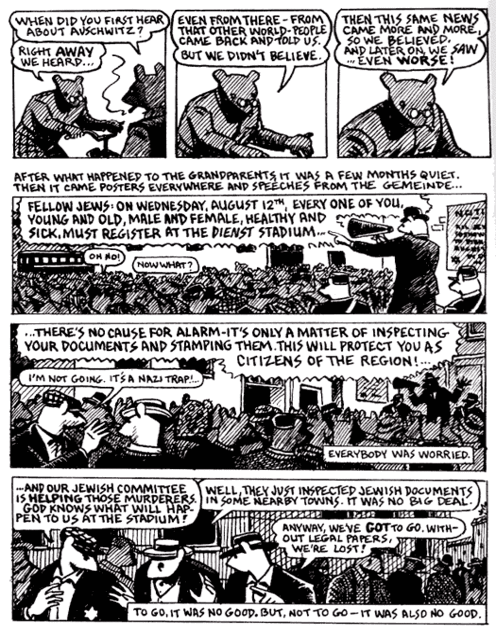Outstanding Scenes
There were many invigorating scenes throughout the storey line though few seemed to stand out among the rest. In Chapter 4 | The Noose Tightens, the German Nazis begin to enforce new and restricting orders, moving Jews to other camps and stripping them of their possessions, later to be exterminated. In one scene, a couple of business men who were dealing goods without food coupons were executed, hung in the city square for a week for everyone to see as seen in figure 1 (Spiegelman, 1986, pp.83). Another stomach turning scene was where Vladek and his family are moved to a camp in Srodula, slowly the Nazis were transferring the Jews to Auschwitz (the gas chambers camp), they would take mostly kids at first whom were only 2-3 years of age. The kids whom would scream and not stop, the German Nazis would swing them by the legs against the wall evidently seen in figure 2 in order to quiet them (Spiegelam, 1986, pp.108).
One of the more interesting scenes was when Spiegelman was looking through an old comic book he made a few years back, it was sitting in his fathers desk. The illustration contained human forms, the protagonist resembling/being Spiegelman and focused on a period of his life where he was dealing with the aftermath of his mother’s suicide. In this scene, there was a very powerful emotion that ran through the content, the scenes were dark, his attire being a prisoners outfit, similar to the one’s Holocaust prisoner’s wore during World War II. There was an emphases on darkness and a depressive state, the prison he was unable to break free from, one of the true unveilings of Spiegelman’s past being recalled, a more purified part of his memoir as seen in figure 3 (Spiegelman, 1986, pp. 100-103).
Figure 1
Figure 2
Figure 3
Characterization
Maus: A Survivor’s Tale evidently portrays the them of Anthropomorphism to define various character traits. Through implementing animal figures such as the Mouse, Pig, Cat, and later on the Dog, stereotyped elements and identities to these certain animals through metaphor, act as an effective identification system (Modlinger, 2009, pp249).
On one hand, Spiegelman describes the story of his father rather than his own story, therefore he is unable to reach an authentic, realistic illustration due to the fact that he did not experience them first handedly. On the other hand it would be impossible to reconstruct every specific detail of the characters and scenes conveyed throughout the storyline. Therefore the idea of abstract characters, or indirect characterization is utilized in hopes of successfully portraying the storyline in an authentic manner (McCloud, 1994, PP7).
“When pictures are more abstracted from 'reality', they require greater levels of perception” -(McCloud, 1994, pp.49)
Reference List
Figure 2 |
Art Tatter. (2009). Art Spiegelman, mouse. The story of a survivor , Fischer Taschenbuch Verlag Frankfurt am Main., 2009. [virtual image]. Retrieved Apr 5, 2015 from http://arttattler.com/archivedurerspiegelmann.html
Figure 3| Maturana, M. (2012). Prisoner on the Hell Planet. [virtual image]. Retrieved Apr 5, 2015 from







